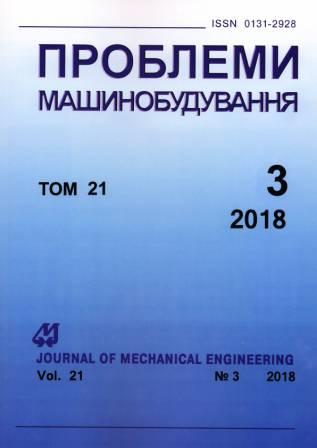Use of Refined Finite Element Models for Solving the Contact Thermoalasticity Problem of Gas Turbine Rotors
Keywords:
three-dimensional finite elements, gas turbine rotors, displacement and temperature fields, contact thermoelasticity problem, clearance, interferenceAbstract
A refined mathematical model of gas turbine engine rotors using three-dimensional finite elements of a curvilinear form is developed. All the calculations were performed for rotors, which are widely used in power machine building and shipbuilding. The fact is that such components have a constructive heterogeneity that can hardly be correctly explained using well-known finite elements and their shape functions. On the other hand, the mathematical model should be as simple as possible with a view to its wide use in the process of designing a rotor. Therefore, a new refined finite-element mathematical model was developed, consisting of three-dimensional curvilinear hexahedral finite elements. It was used to calculate the displacement field caused by the complex action of the heat flux and contact load at the junction of rotor elements. This approach makes it possible to describe the entire rotor as a superposition of the developed curvilinear finite element models and make the calculation process more correct and compact. To solve this problem, a system of matrix equations was compiled. It is based on the use of energy balance dependences in the mechanical contact interaction of rotor elements, as well as the heat balance under the influence of non-stationary heat flow. When creating a numerical algorithm for solving the problem, the direct decomposition of Cholesky was used. To make the solution more compact, the Sherman scheme was used. All the calculations of displacement and temperature fields were carried out for two widely used types of joints, which are used to create such rotors, namely: joints with clearance and interference.References
Pykhalov, A. A. (2007). Staticheskiy i dinamicheskiy analiz sbornykh rotorov turbomashin [Static and dynamic analysis of rotor assembly turbomachines]. –Irkutsk: Izd-vo Irkut. tekhn. un-ta, 194 p. [in Russian].
Tsvik, L. B. (1980). Printsip poocherednosti v zadachakh o sopryazhenii i kontakte tverdykh deformiruyemykh tel [The principle of succession in problems on the conjugation and contact of solid deformable bodies]. Prikadnaya mekhanika – Applied Mechanics, vol.16, no.1, pp. 13−18 [in Russian].
Gail, P. (1999). Isoparametric finite elements for analysis of shell segments and non-axisymmetric shells. Journal of Sound and Vibration, vol. 65, no. 2, pp. 259−273.
Sosunov, V. A., Chepkin, V. M. (2003). Teoriya, raschet i proyektirovaniye aviatsionnykh dvigateley i energeticheskikh ustanovok [Theory, calculation and design of aircraft engines and power plants]. – Moscow: Mosk. energ. in-t, 677 p. [in Russian].
Samarskiy A. A., Vabitsevich P. N. (2009). Vychislitelnaya teploperedacha [Computational heat transfer]. – Moscow: Editorial, 784 p. [in Russian].
Morhun, S. (2017). Improving the mathematical models applied for the solution of solid assembly constructions thermoelasticity problem. Journal of Mechanical Engineering , vol. 20, no. 2, pp. 42−46.
Morhun, S. (2018). The influence of the blade feather constructional inhomogeneity on the turbine cooling blades stress-strain state Eastern European Journal of Enterprise Technologies. Series: Applied Mechanics, no. 2/7 (92), pp. 11−17. DOI: 10.15587/1729-4061.2018.125937.
Downloads
Published
Issue
Section
License
Copyright (c) 2018 Sergey A. Morgun, Aleksey S. Kairov

This work is licensed under a Creative Commons Attribution-NoDerivatives 4.0 International License.
All authors agree with the following conditions:
- The authors reserve the right to claim authorship of their work and transfer to the journal the right of first publication of the work under the license agreement (the agreement).
- Authors have a right to conclude independently additional agreement on non-exclusive spreading the work in the form in which it was published by the jpurnal (for example, to place the work in institution repository or to publish as a part of a monograph), providing a link to the first publication of the work in this journal.
- Journal policy allows authors to place the manuscript in the Internet (for example, in the institution repository or on a personal web sites) both before its submission to the editorial board and during its editorial processing, as this ensures the productive scientific discussion and impact positively on the efficiency and dynamics of citation of published work (see The Effect of Open Access).

